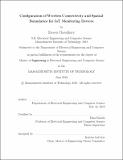| dc.contributor.advisor | Dina Katabi. | en_US |
| dc.contributor.author | Choudhury, Zareen. | en_US |
| dc.contributor.other | Massachusetts Institute of Technology. Department of Electrical Engineering and Computer Science. | en_US |
| dc.date.accessioned | 2019-11-22T00:02:22Z | |
| dc.date.available | 2019-11-22T00:02:22Z | |
| dc.date.copyright | 2019 | en_US |
| dc.date.issued | 2019 | en_US |
| dc.identifier.uri | https://hdl.handle.net/1721.1/123014 | |
| dc.description | This electronic version was submitted by the student author. The certified thesis is available in the Institute Archives and Special Collections. | en_US |
| dc.description | Thesis: M. Eng., Massachusetts Institute of Technology, Department of Electrical Engineering and Computer Science, 2019 | en_US |
| dc.description | Cataloged from student-submitted PDF version of thesis. | en_US |
| dc.description | Includes bibliographical references (page 67). | en_US |
| dc.description.abstract | A common challenge shared by IoT (Internet of Things) devices is to provide a reliable, user-friendly, and scalable configuration system. In this thesis we examine the configuration of WiTrack, a wall-mounted IoT device that provides real-time health monitoring using RF signals. WiTrack requires configuration of two primary components: its wireless connectivity and the boundaries of spaces it collects data from. The present configuration procedure for WiTrack does not function in all deployment environments, requires expert knowledge, and does not scale well. This thesis introduces the first configuration system for WiTrack, comprised of two subsystems: ConnectivityManager and SpaceManager. ConnectivityManager enables configuration of WiTrack's wireless connection, and SpaceManager allows configuration of spatial boundaries by tracking an individual's movement throughout a space. We evaluated both systems through a user study consisting of eight participants in six unique homes. We found that ConnectivityManager successfully allows configuration of all network security types, and SpaceManager produces boundaries that are accurate within 0.5 meters. The full deployment process can be completed within 15 minutes, and the systems reduce sources of human error as well as effort required for deployment. Compared to the previous configuration process, ConnectivityManager and SpaceManager represent a significant improvement in functionality, time, and usability for WiTrack deployments. | en_US |
| dc.description.statementofresponsibility | by Zareen Choudhury. | en_US |
| dc.format.extent | 67 pages | en_US |
| dc.language.iso | eng | en_US |
| dc.publisher | Massachusetts Institute of Technology | en_US |
| dc.rights | MIT theses are protected by copyright. They may be viewed, downloaded, or printed from this source but further reproduction or distribution in any format is prohibited without written permission. | en_US |
| dc.rights.uri | http://dspace.mit.edu/handle/1721.1/7582 | en_US |
| dc.subject | Electrical Engineering and Computer Science. | en_US |
| dc.title | Configuration of wireless connectivity and spatial boundaries for IoT monitoring devices | en_US |
| dc.type | Thesis | en_US |
| dc.description.degree | M. Eng. | en_US |
| dc.contributor.department | Massachusetts Institute of Technology. Department of Electrical Engineering and Computer Science | en_US |
| dc.identifier.oclc | 1127580180 | en_US |
| dc.description.collection | M.Eng. Massachusetts Institute of Technology, Department of Electrical Engineering and Computer Science | en_US |
| dspace.imported | 2019-11-22T00:02:21Z | en_US |
| mit.thesis.degree | Master | en_US |
| mit.thesis.department | EECS | en_US |
